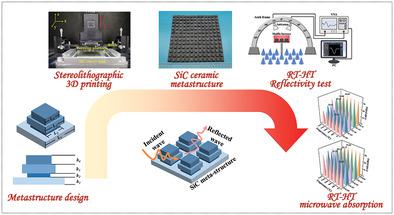当前位置:
X-MOL 学术
›
Adv. Mater. Technol.
›
论文详情
Our official English website, www.x-mol.net, welcomes your
feedback! (Note: you will need to create a separate account there.)
Stereolithographically 3D Printed SiC Metastructure for Ultrabroadband and High Temperature Microwave Absorption
Advanced Materials Technologies ( IF 6.4 ) Pub Date : 2022-10-21 , DOI: 10.1002/admt.202201222 Niping Zhou 1 , Lu Zhang 1 , Wenqing Wang 1 , Xueqin Zhang 1 , Keqiang Zhang 1 , Mingji Chen 1 , Yixing Huang 1 , Rujie He 1, 2 , Daining Fang 1
Advanced Materials Technologies ( IF 6.4 ) Pub Date : 2022-10-21 , DOI: 10.1002/admt.202201222 Niping Zhou 1 , Lu Zhang 1 , Wenqing Wang 1 , Xueqin Zhang 1 , Keqiang Zhang 1 , Mingji Chen 1 , Yixing Huang 1 , Rujie He 1, 2 , Daining Fang 1
Affiliation

|
Broadband microwave absorption is essential on the realms of electromagnetic compatibility and protection in civil application scenarios. However, coordination of material and structure is difficult without proper iterative design between material and structure resulting in insurmountable drawbacks of traditional microwave absorption medium operating under high temperature erosion. Herein, SiC metastructure is manufactured in bulk by stereolithographic 3D printing. The dielectric loss tangent of SiC sintered body is over 0.5 and up to 1.5 at most showing good electromagnetic energy dissipation properties. The optimized SiC metastructure with complicated suspended features achieves −10 dB broadband microwave absorption from 6.96 to 40 GHz at room temperature (RT) across total frequency range of 33.04 GHz. The proposed SiC metastructure is able to endure in situ 1000 °C and ex situ 1600 °C erosion in air atmosphere maintaining −10 dB effective bandwidth in 4.54–40 and 10.89–39.67 GHz, respectively. Broadband microwave absorption under oblique incidence from 0° to 60° is also achieved in a wide temperature range from RT to 1600 °C. The densification of SiC results in a high mechanical strength of 217.36 MPa for structural load bearing applications. The intrinsic electromagnetic variation of SiC under different temperature is relaxed and adapted to the metastructure design. The functions of broadband microwave absorption and high temperature protection are integrated into one metastructure.
中文翻译:

用于超宽带和高温微波吸收的立体光刻 3D 打印 SiC 元结构
宽带微波吸收对于民用应用场景的电磁兼容和防护领域至关重要。然而,如果没有适当的材料和结构之间的迭代设计,材料和结构的协调是困难的,导致传统的微波吸收介质在高温侵蚀下工作无法克服的缺点。在此,SiC 元结构通过立体光刻 3D 打印批量制造。SiC烧结体的介电损耗角正切大于0.5,最高可达1.5,显示出良好的电磁能量耗散性能。经过优化的 SiC 元结构具有复杂的悬浮特征,在 33.04 GHz 的总频率范围内,在室温 (RT) 下实现了 6.96 至 40 GHz 的 −10 dB 宽带微波吸收。拟议的 SiC 超结构能够承受空气中的原位 1000 °C 和非原位 1600 °C 侵蚀,分别在 4.54–40 和 10.89–39.67 GHz 保持 −10 dB 有效带宽。在从 RT 到 1600 °C 的宽温度范围内,在 0° 到 60° 的斜入射下也实现了宽带微波吸收。SiC 的致密化导致结构承载应用的 217.36 MPa 的高机械强度。SiC 在不同温度下的固有电磁变化得到放松并适应元结构设计。宽带微波吸收和高温保护功能集成在一个元结构中。在从 RT 到 1600 °C 的宽温度范围内,在 0° 到 60° 的斜入射下也实现了宽带微波吸收。SiC 的致密化导致结构承载应用的 217.36 MPa 的高机械强度。SiC 在不同温度下的固有电磁变化得到放松并适应元结构设计。宽带微波吸收和高温保护功能集成在一个元结构中。在从 RT 到 1600 °C 的宽温度范围内,在 0° 到 60° 的斜入射下也实现了宽带微波吸收。SiC 的致密化导致结构承载应用的 217.36 MPa 的高机械强度。SiC 在不同温度下的固有电磁变化得到放松并适应元结构设计。宽带微波吸收和高温保护功能集成在一个元结构中。SiC 在不同温度下的固有电磁变化得到放松并适应元结构设计。宽带微波吸收和高温保护功能集成在一个元结构中。SiC 在不同温度下的固有电磁变化得到放松并适应元结构设计。宽带微波吸收和高温保护功能集成在一个元结构中。
更新日期:2022-10-21
中文翻译:

用于超宽带和高温微波吸收的立体光刻 3D 打印 SiC 元结构
宽带微波吸收对于民用应用场景的电磁兼容和防护领域至关重要。然而,如果没有适当的材料和结构之间的迭代设计,材料和结构的协调是困难的,导致传统的微波吸收介质在高温侵蚀下工作无法克服的缺点。在此,SiC 元结构通过立体光刻 3D 打印批量制造。SiC烧结体的介电损耗角正切大于0.5,最高可达1.5,显示出良好的电磁能量耗散性能。经过优化的 SiC 元结构具有复杂的悬浮特征,在 33.04 GHz 的总频率范围内,在室温 (RT) 下实现了 6.96 至 40 GHz 的 −10 dB 宽带微波吸收。拟议的 SiC 超结构能够承受空气中的原位 1000 °C 和非原位 1600 °C 侵蚀,分别在 4.54–40 和 10.89–39.67 GHz 保持 −10 dB 有效带宽。在从 RT 到 1600 °C 的宽温度范围内,在 0° 到 60° 的斜入射下也实现了宽带微波吸收。SiC 的致密化导致结构承载应用的 217.36 MPa 的高机械强度。SiC 在不同温度下的固有电磁变化得到放松并适应元结构设计。宽带微波吸收和高温保护功能集成在一个元结构中。在从 RT 到 1600 °C 的宽温度范围内,在 0° 到 60° 的斜入射下也实现了宽带微波吸收。SiC 的致密化导致结构承载应用的 217.36 MPa 的高机械强度。SiC 在不同温度下的固有电磁变化得到放松并适应元结构设计。宽带微波吸收和高温保护功能集成在一个元结构中。在从 RT 到 1600 °C 的宽温度范围内,在 0° 到 60° 的斜入射下也实现了宽带微波吸收。SiC 的致密化导致结构承载应用的 217.36 MPa 的高机械强度。SiC 在不同温度下的固有电磁变化得到放松并适应元结构设计。宽带微波吸收和高温保护功能集成在一个元结构中。SiC 在不同温度下的固有电磁变化得到放松并适应元结构设计。宽带微波吸收和高温保护功能集成在一个元结构中。SiC 在不同温度下的固有电磁变化得到放松并适应元结构设计。宽带微波吸收和高温保护功能集成在一个元结构中。











































 京公网安备 11010802027423号
京公网安备 11010802027423号